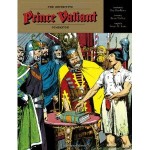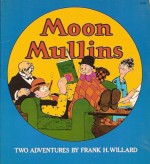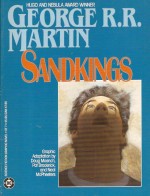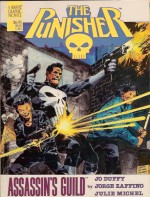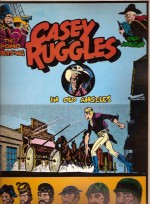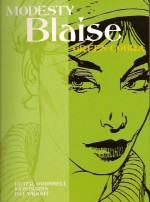
By Peter O’Donnell, John Burns & Pat Wright (Titan Books)
ISBN 13: 1-84576-420-3
Titan Books’ marvellous series re-presentation the classic British newspaper strip continues and concludes a period of artistic instability with this fourteenth volume (encompassing April 2nd 1979 to May 23rd 1980) as the superb John M. Burns finishes his groundbreaking and far too brief tenure as illustrator on the World’s Greatest Adventure Heroine, abruptly replaced mid-strip by veteran Pat Wright – who also didn’t stick around for very long…
Burns had worked on Junior Express and School Friend but really began his auspicious rise as part of the team of artists who worked on the Gerry Anderson licensed titles TV Century 21 and its sister magazines (he is fondly remembered for Space Family Robinson in Lady Penelope). He drew strips for The Daily Sketch, Daily Mirror and Sun with long, acclaimed runs on The Seekers and the saucy strip Danielle, before briefly and controversially taking over Modesty Blaise.
He has since worked on TV-based series for Look-In and Countdown and found a welcome home in the legendary British science fiction comic 2000AD, where he works on Judge Dredd, Nikolai Dante and his own Bendatti Vendetta.
Although Burns only drew 272 consecutive daily strips, his influence on Modesty was marked and long-lasting. His deft ability with nib and brush are highlighted here with a further complimentary feature reprinting 6 more of the illustrations he drew for O’Donnell’s Modesty prose novels. Also included is another text feature on the oddly arbitrary editorial censorship the strip endured at this period, and particularly the rather heavy-handed manner in which Cartoon Editor Gerald Lip was ordered by Evening Standard Editor Charles Wintour to summarily fire Burns, and ten months later, after only 198 strips, Wright as well, in just as brusque and inexplicable a manner. To this day no one why they were dismissed.
Of Pat Wright himself I know very little, other than he is an exceptionally talented draughtsman, well capable of handling a dramatic feature like Modesty, and also a highly skilled comedy cartoonist working in both line and painted colour. He looks to have been one of the artists used by Fleetway in the late 1970’s on such titles as Action and Valiant (but I’m only guessing here). Just another unsung hero of an industry far too reticent in giving credit where it’s due…
Modesty and Willie Garvin are ex-criminals who retired young, rich and healthy from a career where they made far too many enemies. They were slowly dying of boredom in England when British Spymaster Sir Gerald Tarrant offered them a chance to have fun, get back into harness and do a bit of good in the world. Accepting, they have never looked back…
This volume begins with the eponymous ‘Green Cobra’ and finds Burns at his most effective in a sly and gripping tale of intrigue wherein a band of professional espionage agents kidnap Tarrant’s right hand man Fraser, with a view to breaking and selling him to the highest bidder.
This is a tale rich in character, which spends some welcome time on the bit-players for a change, although when Modesty and Willie go into action against the devilish Dr. Vigo and Pandora, an death-crazed assassin who covets Modesty’s hard-earned reputation, the pace is hectic and the action non-stop. Full of twists and clever subterfuge, this tripartite struggle between Tarrant’s agents, established enemy network Salamander Four and the mysterious new organisation Green Cobra all add to one of the most captivating Modesty yarns ever.
‘Eve and Adam’ is a deliciously quirky tale blending whimsy with terrifyingly grim geopolitical horrors as millionaire philanthropist Dan Galt throws a party for Modesty and Willie, before drugging and transporting them to an isolated part of Africa. It transpires that Galt is dying and believes that humanity will soon follow him. Determined that the race will not be lost he dumps his guests naked and helpless in his new Garden of Eden expecting them to repopulate the world after we’re all gone.
Sadly the old duffer has made a few wrong assumptions. Firstly, Modesty and Willie are simply unable to relate to each other sexually – their bond is far deeper than that. Secondly, the world just isn’t that big anymore: Galt’s oasis in the middle of a desert is disputed territory warring African nations are seeking to control, and finally, his new Adam and Eve are never helpless…
As the pair are preparing to trek out of the desert a satellite crashes into their garden, carrying geological data that the state of Burenzi and its opponent nations will kill to possess. Before too long a small unit from the former and a large troop of mercenaries from the latter have invaded paradise, and they’re not the kind of people who leave witnesses…
Burns was fired without warning or explanation four weeks into this saga and Pat Wright deftly took over just as the bloodshed of a brutal war of attrition escalated, with Modesty and Willie making alliances and picking off ruthless soldiers in a gritty, effective contemporary thriller.
This volume, and Wright’s artistic tenure end with a thoroughly engaging Christmas themed crime-mystery ‘Brethren of Blaise’ which finds our tarnished heroes exposing a criminal scheme perpetrated against one of England’s most impoverished aristocratic families. Hidden treasure, nasty murders and a delightfully thrilling supernatural frosting combined with superb humour and action make this an exception tale in an often grim canon.
During this tale, and once more for no apparent reason, Editor Wintour had Modesty’s illustrator fired. His replacement, Neville Colvin, managed to survive a while longer…but that’s a tale for another graphic novel and a different review.
Originally a newspaper strip created by Peter O’Donnell and drawn by the brilliant Jim Holdaway, Modesty and her charismatic partner in crime (and latterly crime-busting) Willie Garvin have also starred in 13 prose novels and short story collections, two films, one TV pilot, a radio play and nearly one hundred comic strip adventures between 1963 and the strip’s conclusion in 2002. She has been syndicated world-wide, and Holdaway’s version has been cited as an artistic influence by many major comic artists.
These are unbeatable stories from a brilliant writer and his greatest creation; timeless tales of crime and punishments more enthralling now than ever, and which never fail to deliver maximum thrills and enjoyment. It’s never too late to embrace your Modesty…
© 2008 Associated Newspapers/Solo Syndication.




